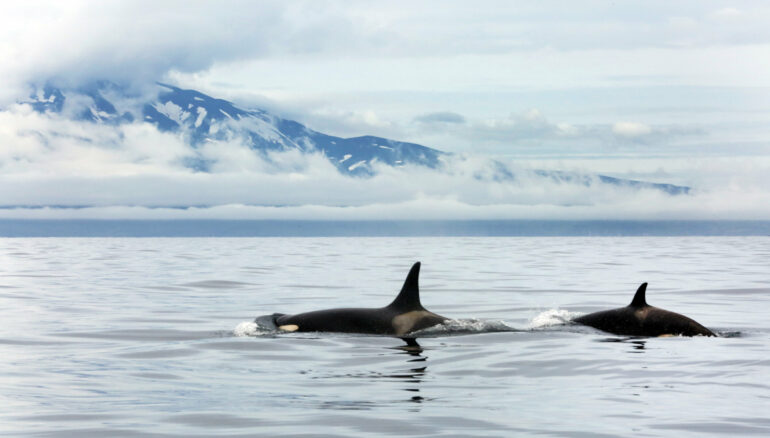The northern Pacific near Japan and Russia is home for several different groups of orcas. They have no contact with each other, do not seek the same food, do not speak the same dialect, and do not mate with each other. How can this be when they live so close to each other and belong to the same species?
Whale biologist Olga Filatova, University of Southern Denmark, is interested in finding out how the northern Pacific has been colonized by orcas, and during her time at university in Moscow, she conducted several expeditions to the area. Today, she is with University of Southern Denmark’s Marine Biological Research Center.
Now, some of her latest results have been published. In a recent paper published in Marine Mammal Science, she and colleagues explore the complex interaction between orca culture and post-glacial history of their colonization of the North Pacific, showing that the orca pods currently living near Nemuro Strait in northern Japan are descendants of orcas that settled there during the last ice age, around 20,000 years ago. The location was chosen as a refugium by distant ancestors, and their descendants have lived there ever since.
“Orcas are conservative and tradition-bound creatures who do not move or change their traditions unless there is a very good reason for it. We see that in this population,” says Filatova.
This is the second time she has found an orca refugium from the Ice Age. The first one is near the Aleutian Islands, some 2500 km away. The pods there are just as conservative and tradition-bound as their Japanese conspecifics, and are also descendants of Ice Age ancestors who found refuge in ice-free waters.
“When the ice began to retreat again, and orcas and other whales could swim to new ice-free areas, some of them did not follow. They stayed in their [refugia], and they are still living there,” says Filatova.
The studies are based on genetic analyses (the researchers took skin biopsies of the animals) and analyses of sounds made by the animals (recorded with underwater microphones).
“Orcas in the Nemuro Strait had unusually high genetic diversity, which is typical for glacial [refugia], and their vocal repertoire is very different from the dialects of orcas living to the north off the coast of Kamchatka. Kamchatkan orcas are most likely the descendants of the few pods that migrated west from the central Aleutian refugium; that’s why they are so different,” says Filatova.
Orcas’ vocalizations are highly diverse, and no two pods make the same sounds. Therefore, these sounds can be used to identify individuals’ affiliations to families and pods. Orcas are not genetically programmed to produce sound, for example, the way a cat is. A cat that grows up among other animals and has never heard another cat will still meow when opening its mouth. In contrast, orcas learn to communicate from their mother or other older family members. Each pod has its own dialect, not spoken by others.
“When we combine this with genetic analyses, we get a strong idea of how different orca communities relate to each other,” says Filatova.
So far, two Ice Age refugia have been discovered, providing us with insight into how orcas may handle current and future climate changes: They will likely move northward as the ice melts, and this colonization may happen in small, individual families or pods rather than in large waves.
The discovery of the two Ice Age refugia not only contributes to knowledge about how orcas survived during the Ice Age, but it also paints a picture of orcas as very different animals that may not fit neatly into one species.
“Many believe that orcas should be divided into several species. I agree—at least into subspecies because they are so different that it doesn’t make sense to talk about one species when discussing their place in the food chain or when allocating quotas to fishermen,” says Filatova.
Some orcas eat fish, some only herring, some only mackerel, some only a specific type of salmon. Others only eat marine mammals such as seals, porpoises, and dolphins. Some take a little of everything, and still others live so far out in the open sea that we fundamentally know very little about them.
Whether a pod eats fish—and which fish—has a significant impact on the fishing that takes place in their habitat. When a country calculates fishing quotas, it must take into account how many fish are naturally hunted by predators, and since an orca can consume 50–100 kg of fish in a day, it greatly affects the quota calculation.
If pods eat marine mammals and do not touch fish, this matters if they are to be captured and sold to marine parks, where it is difficult to feed them marine mammals. While marine parks’ popularity is declining worldwide, there is still a large market for orcas in Chinese marine parks.
Since there is only one scientifically recognized species of orcas, researchers have resorted to a different form of classification to distinguish between different types of orcas and categorize them into so-called ecotypes. In the northern Pacific, three ecotypes have been defined so far, and in the southern hemisphere, four or five have been described.
There are probably more—perhaps up to 20 different ecotypes, according to Filatova.
“We need to know the different ecotypes. Orcas are at the top of the food chain, and it affects the entire ecosystem around them what they eat and where they do it,” she says.
In the Danish waters, Skagerrak and Kattegat, close to the SDU Marine Biological Research Center, orcas are occasionally seen. Yet, no one knows if they eat fish or marine mammals—and therefore, also, how they affect the food chain and fishing.
“I look forward to learning more about them. Maybe they turn out to belong to a new ecotype,” says Filatova.
More information:
Olga A. Filatova et al, Genetic and cultural evidence suggests a refugium for killer whales off Japan during the Last Glacial Maximum, Marine Mammal Science (2023). DOI: 10.1111/mms.13046
Provided by
University of Southern Denmark
Citation:
Researchers find 20,000-year-old refugium for orcas in the northern Pacific (2023, August 21)



